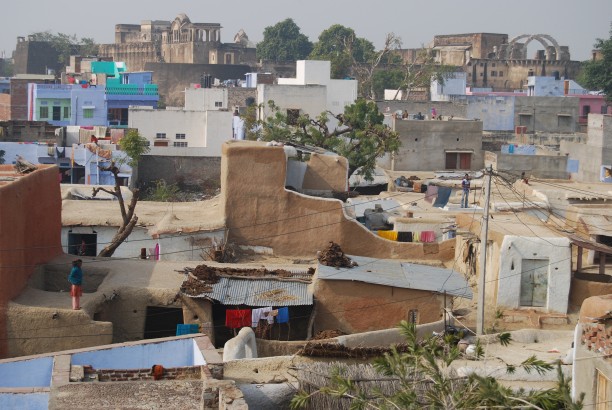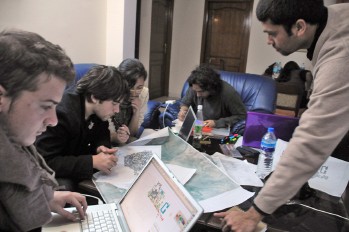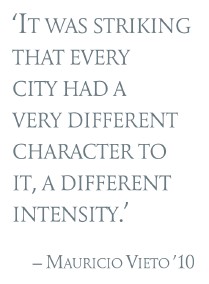ARTS AND HUMANITIES

The walled town of Diggi in Rajasthan, where Cornell students conducted a survey of residents to assist with the towns planning and development needs.

City and regional planning professor Jeffrey Chusid, at center rear, points out the architectural features of chattels, a type of building in Mumbai, to the MOAAP student group. See larger image

Children and other residents accompany students Ray Mensah (holding map) and Giselle Denbow (to Mensahs left) during their survey of the town of Diggi. See larger image

At left, middle image: Students prepare a presentation of their findings in Diggi to the thakur (leader) of the town. From left: Mauricio Vieto, Roberto Soto, Kai Fukunaga and Nick Savvides, with architect Bhaskar Srivastava, who assisted the group in India (photo by Jeffrey Chusid). See larger image
Trip to India becomes village classroom project for minority student planners
Twelve students in the Minority Organization of Architecture, Art and Planning (MOAAP) returned from a three-week winter break trip to India with a sense of purpose -- to turn their field experiences into meaningful results for some of the people they encountered.
The trip, from Dec. 31 to Jan. 21, was a student-led initiative that took the group to several sites, from Delhi to Mumbai. Students spent about a week doing fieldwork in Diggi, a rural community that lacks basic infrastructure and services for residents yet welcomes 100,000 pilgrims annually who travel to a Hindu temple there.
City and regional planning associate professor Jeffrey Chusid accompanied the group, which also visited urban centers, the Taj Mahal, museums and other cultural and historic sites; and met with planning professionals, architects and artists.
"It was striking that every city had a very different character to it, a different intensity," says Mauricio Vieto '10. "Jaipur feels more hectic; Mumbai feels more Western, more tourist-friendly."
Their service-learning project in Diggi, a town of 7,000 people about 50 miles from Jaipur, was conducted in tandem with local efforts to aid planning and economic development.
"We had our best interactions with people in Diggi," architecture student Nick Savvides '14 says.
The town attracts more domestic tourists and pilgrims than international visitors, and the stream of visitors is steady even without cafes, hotels or other services, the group discovered.
"There were very unique features to the town, some of them found no place else," says Lola Osho '10. "It's very well-maintained."
The students conducted neighborhood surveys, interviewing residents about "how the town functions, from sewage to hosting people there for pilgrimages … it's a very old place, and there's not a lot of documentation," MOAAP President Khaleel Atiyyeh '10 says.
The residents appeared comfortable talking about issues in the town that they might not have discussed with the thakur, their local leader, the students noticed.
"I think an important thing we had to offer them was reinforcement -- while you may have an idea of what the issues are in your town, it's good to have outside people confirm that," Fernando Montejo '10 says.
The thakur, Rampratap Singh, also went "to great lengths to prepare housing, feed the group three meals a day, and make arrangements for guides, doctors and almost anything else we needed," Chusid says.
The students are compiling the information they gathered as part of a two-credit urban planning course with Chusid. The group also plans an exhibit for late March or early April in the Willard Straight Hall Art Gallery.
"As an urban planner, going in to this place that was so untapped was interesting," Laura Friend '10 says. "Most interesting was seeing the traditional methods of everyday life right alongside the modern."
The Cornell group included 10 students from the College of Architecture, Art and Planning; one from the ILR School; and one from the College of Engineering. MOAAP membership is open to all Cornell students.
The students raised funds for the trip throughout the fall semester. Chusid and city and regional planning professor Michael Tomlan structured the itinerary. The group was joined in India by Ravi Kaimal of Delhi-based architecture firm KCA, who "made the connection to the town, prepared the base maps and other materials we used, and spent time working on site with us," Chusid says.
Bhaskar Srivastava, a New York-based architect educated in Rajasthan, also assisted "with understanding the region, translation and documentation," Chusid says.
The spring semester work, along with the material produced during the trip, will be turned over to KCA and the thakur this summer, to advance planning for the town.
